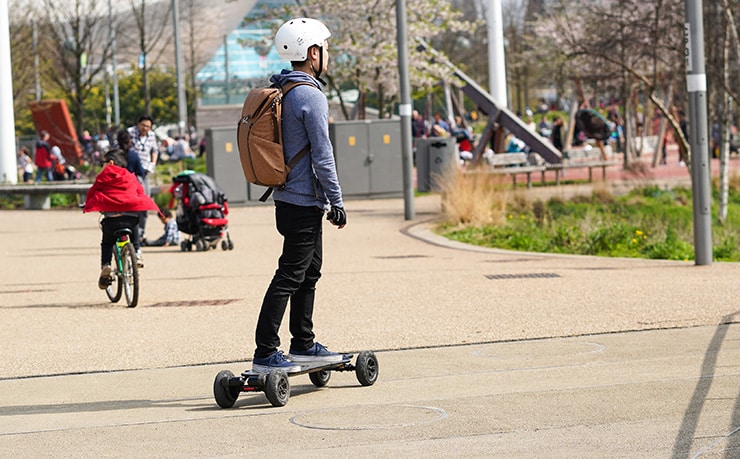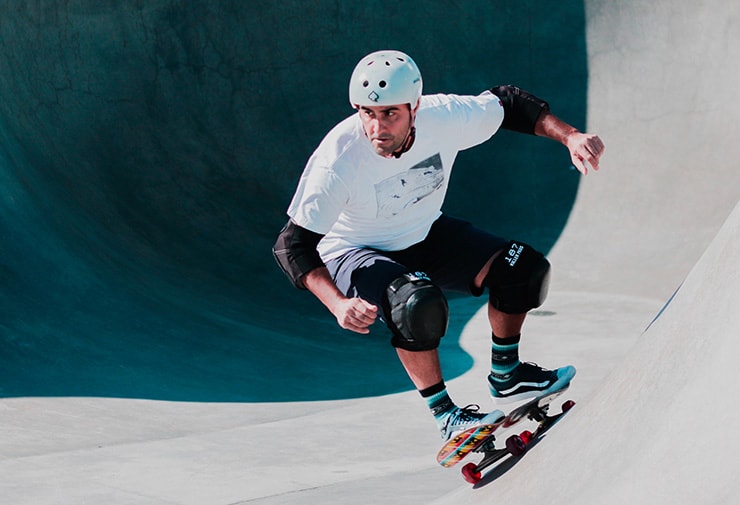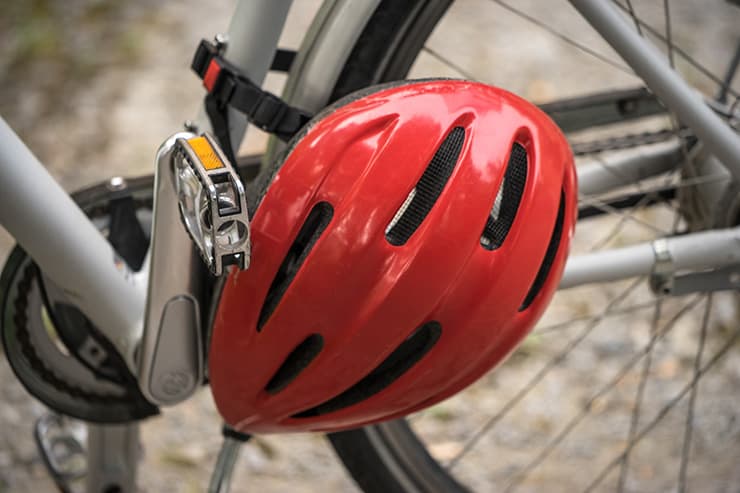Safety should always come first when cycling and skateboarding, which is why you need a helmet. Skateboard helmets and bike helmets are similar in many ways. Some people think they’re interchangeable.
A helmet is more than just an accessory to look cool while cycling or skating. Accidents aren’t uncommon; you can save yourself a lot of trouble by wearing the correct safety equipment. According to this National Library of Medicine journal, different studies show that bike helmets can reduce head and brain injuries by 63 to 88%.
Knowing this, it’s essential to understand the difference between a bike and a skate helmet. You want to ensure you’re buying or wearing the right one. It’s also good to know whether they’re interchangeable for those who are both skateboarders and cyclists.
I’m going to dive deep into the skateboard helmet vs. bike helmet discussion. I’ll talk about their differences, certification, and everything else you need to know.
Key Takeaways
- Skateboard helmets and bike helmets are similar in many ways, but they are designed to protect the wearer from different types of impacts and injuries.
- Skate helmets offer more coverage for the back of the head, temples, and ears, while bike helmets cover the top and front of the head.
- Skate helmets also have a hard and thick shell that can withstand multiple impacts, while bike helmets have a thin and light shell that crushes on impact.
- Skate helmets use EPP foam, which is rubbery and recovers after impact, while bike helmets use EPS foam, which is crushable and does not recover after impact.
- Bike helmets have more and larger vents than skate helmets to allow for better ventilation and cooling. Bike helmets also have a more aerodynamic shape too.
The Difference Between a Bike Helmet and a Skateboard Helmet
Skate and bike helmets may be similar in some ways, but they’re quite different. Usually, helmets are designed to protect you from the type of impact common in a particular activity. It’s no different for skating and cycling.
So here are the differences between the two helmets.
Shape and Coverage
Bike and skate helmets have different shapes and provide different types of head coverage.
Skate helmets offer more coverage because there are many ways to fall while skateboarding. It covers more of the back of your head and even your temples and ears.
When cycling, it’s highly unlikely to fall on your back. So a typical bicycle helmet won’t offer much coverage for the back of your head. It covers the top and sits low on your forehead but doesn’t cover the lower part of the back of your head.
However, it depends on the type of cycling you’ll be doing because, as mentioned, a helmet protects you from the most common kind of impact.
Most road bike helmets, for instance, will not cover the lower back of your head. But you might see some mountain bike helmets and BMX helmets with more coverage that extends to the back of the head.

Shell and Foam Material
Another key difference between bike and skate helmets is the material used to make them.
First, bike helmets and skate helmets will usually have different types of foam.
Expanded Polystyrene (EPS) and Expanded Polypropylene (EPP) are some of the most commonly used foams in helmets. EPP is a multi-impact foam, while EPS is single-use only.
Skate helmets mainly utilize EPP foam. This foam is rubbery and, unlike the foam in a bike helmet, it recovers after impact. It can protect you from multiple impacts if you fall several times.
Bike helmets, on the other hand, will most likely have EPS foam. It’s a crushable foam that protects you from one large impact. If you get into an accident, the foam crushes and protects your head from impact.
This crushing reduces its ability to cushion you from another impact. So you have to replace the helmet despite no visible damage.
Skateboard helmets also have a hard and thick outer shell that can handle multiple impacts, just like foam. On the other hand, bicycle helmets have a thinner and lighter shell that won’t slow you down.
Ventilation
When you look at skating and cycling helmets side by side, you’ll notice that skate helmets have fewer “holes,” which are also smaller. The ones in a bike helmets are more in number and bigger.
Good ventilation in bike helmets is essential, especially during intense or long-distance cycling. The vents allow proper air circulation to prevent cyclists from getting too hot and uncomfortable.
Skate helmets also have vents because you still need proper air circulation while skating. But, as mentioned, they are smaller and fewer since skating is less physically taxing than biking.

Impact Capacity
As already discussed, cycling and skateboarding helmets feature different types of foams and shell materials. This affects their impact capacity.
A bike helmet will protect the wearer from one big impact, like a collision with a car. After that, the foam crushes and doesn’t go back to its original form.
A skating helmet, however, can handle several impacts before it eventually loses its ability to protect its wearer.
Difference in Style
Skate-style helmets have a smooth, round shape. They fit more snuggly, have thinner padding on the inside, and can, therefore, be uncomfortable when you wear them for long periods.
Many bike helmets are neither round nor smooth. Looking at them from the side, they may appear elongated, and some have a visor. They are also lighter with more padding, making them comfortable even for longer rides.
Another thing, since skating helmets have a smooth surface and fewer vents, you can find all manner of cool patterns and graphics on them. Bike helmets have a lot of vents, and most of them are just plain.
Aerodynamic Design
Lastly, bicycle helmets have a more aerodynamic design compared to skate helmets.
The aerodynamic design helps you overcome wind resistance, which is especially important when racing.
There are even special aero bicycle helmets that have a more streamlined shape than the traditional bike helmet. But some of them are smoother and designed with fewer holes which can make them warm and uncomfortable.
Certification on Helmets
There are different helmet safety standards that helmets have to meet, depending on what they’re designed for. This shows they have been specifically made and tested to protect the wearer from a more severe head injury or skull fracture.
Bike helmets, for instance, must be up to the Consumer Product Safety Commission (CPSC) bicycle helmet standard. According to this standard, the straps have to be sturdy and ensure that your helmet stays on and in place in the event of an accident. Bicycle helmets that meet this standard will have a label to show that.
Skate helmets are required to meet the ASTM F1492 standard. Meeting this standard shows that the helmet is a multi-impact helmet and will protect you from several moderate impacts. They don’t offer adequate protection from serious impact.
Some skate helmets today are dual-certified, and they have both CPSC and ASTM certifications.
Can You Use a Skateboard Helmet for Cycling?

You have seen the difference between biking helmets and skate helmets. Ultimately, they are both designed to accomplish the same thing: protect you from a head injury in case of impact. But can you use one in place of the other?
Helmets save lives, so wearing the correct helmet for a specific activity is something you should take seriously.
Using a skateboard helmet for cycling is not wise. As you have seen, a skate helmet is designed to withstand multiple impacts–moderate ones at that. If it doesn’t have CPSC certification then it will most likely not protect you in a serious biking accident.
Besides, skating helmets don’t have as many vents as biking helmets, so that you may be uncomfortable too. However, this will depend on the weather and the nature of your rides.
How about using a bike helmet for skateboarding?
A bicycle helmet is designed to withstand one large impact. After that, you must dispose of it and get a new one. That wouldn’t be very economical if you decide to use one for skateboarding as falls are quite common. And don’t forget that many bike helmets don’t adequately cover the back of your head.
Because of this, it’s important to wear helmets that are designed for the activity you will be doing. They should also have the proper certification.
Is It Time to Replace Your Helmet?
In addition to wearing the correct helmet, you also want to ensure it’s in good condition.
If your bicycle or skateboarding helmet has visible damage, that’s an obvious sign that it’s time to get a new one. The damage may be cracks, wear and tear, straps that won’t hold, etc.
Bicycle helmets are single-hit helmets. So if you get into an accident and the helmet takes a serious hit, you’ll need to replace it. This applies whether or not there’s visible damage. Remember, the foam in the helmet will crush and won’t recover. It won’t protect your head in case of another fall.
Frequently Asked Questions
Is a Bike Helmet OK for Skateboarding?
Generally, no, a bike helmet is not okay for skateboarding. A regular bike helmet doesn’t adequately cover the back of the head like a skate helmet. Another thing, the inner foam in a bike helmet is single-use only and will crash on impact. A skate helmet is designed to protect you from a few soft blows.
If you want to use one helmet for both activities, get a multi-use helmet with dual certification.
Why Do Bike Helmets Have Holes?
Bike helmets have holes for ventilation. Cycling is a physically demanding activity. Your head can quickly get uncomfortable as you produce heat and sweat while cycling. The holes allow for air circulation and keep your head cool.
Are Bike Helmets Actually Safer?
Yes, bicycle helmets are safer, and they save lives. In case of a fall, the helmet absorbs the impact. This offers protection from head injuries and fractures.
It is, therefore, important to make sure you wear the proper helmet for your cycling style.
Should a Bike Helmet Cover Your Forehead?
Yes, your bicycle helmet should cover your forehead. The front edge should be no more than two finger widths from your eyebrows.
Bottom Line: Skateboard Helmet Vs Bike Helmet, Does It Matter?
All helmets are not the same. Different helmets are carefully designed and tested to protect the user from the most common type of impact associated with a specific activity.
Skateboard helmets and bike helmets have some similarities. But they also have differences and are, in most cases, not interchangeable.
Most cycling helmets do not cover the lower back of your head, while skate helmets cover the back of your head correctly. This is mainly because while skateboarding, you are likely to fall on your back–it’s not the case while cycling.
One major difference between these two helmets is the protective foam you find inside them. The foam in a skate helmet is designed to protect you from multiple minor hits. The foam in a bicycle helmet protects you from one major hit.
Always make sure you wear the correct helmet for the activity you will be doing, and it should be a certified helmet too.

